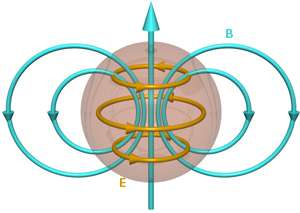Tiny spheres of silicon can control magnetic side of light, paving way to novel optical devices

Light is an oscillating wave of electric and magnetic fields. The way the electric field component interplays with the atoms in a material largely determines how light interacts with matter. With visible light, however, the influence of the magnetic component is usually much smaller. Arseniy Kuznetsov at the A*STAR Data Storage Institute, Singapore, and co‐workers have now created tiny spheres of silicon that can strongly interact with the magnetic field of visible-wavelength light. These engineered 'magnetic materials' enable new ways of controlling light at the nanoscale.
Relative permeability is a measure of a substance's ability to support a magnetic field. Most optical materials have a permeability approximately equal to one. A more diverse choice, however, would open the door to a whole host of novel optical devices. Negative permeability, for example, could be used to create high-resolution lenses and even invisibility cloaks. As no such materials exist in nature, scientists have started to develop metamaterials, which are artificial structures engineered to interact with light in a desired way. Kuznetsov and co-workers have shown that nanoscale engineering provides a way of tuning the magnetic properties of silicon nanoparticles.
The researchers fired a high-intensity laser at a silicon wafer, which blasted off spheres of silicon with diameters between 100 and 200 nanometers. The separation between the spheres was large enough that the researchers could see them individually under an optical microscope. They could also see that the nanoparticles scattered light of all colors in the rainbow, from red to violet.
In a theoretical analysis, Kuznetsov and co-workers showed that the optical response resulted from incoming light generating a circular electric field, or displacement current, in the sphere. This, in turn, supported an oscillating magnetic field in the middle of the particle—a so-called magnetic dipole (see image). "We have experimentally demonstrated that silicon nanoparticles can have strong electric and magnetic dipole resonances in the visible spectrum," explains Kuznetsov. "The advantage of our approach is that it is free of energy loss because the modes are not related to real electron currents."
The properties of the dipole were dependent on the size of the particle, so particles of different sizes scattered light of different colors. The team predicts that more sophisticated fabrication techniques will soon enable greater control over a nanoparticle's size and shape, thus enabling selective tuning of its optical properties. "Our future research will target possible applications of these nanoparticles and the realization of novel nanodevices for light-on-a-chip integration," says Kuznetsov.
More information: Kuznetsov, A. I., Miroshnichenko, A. E., Fu, Y. H., Zhang, J. & Luk'yanchuk, B. Magnetic light. Scientific Reports 2, 492 (2012). dx.doi.org/10.1038/srep00492
Journal information: Scientific Reports



















